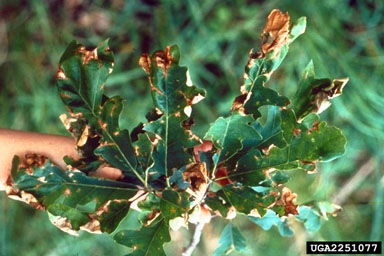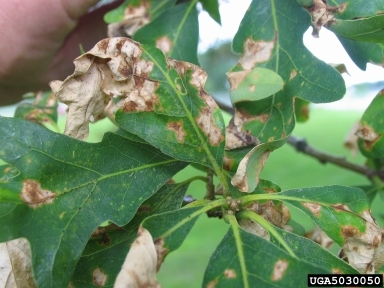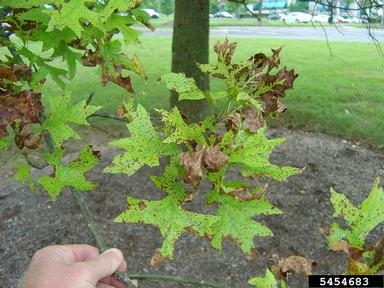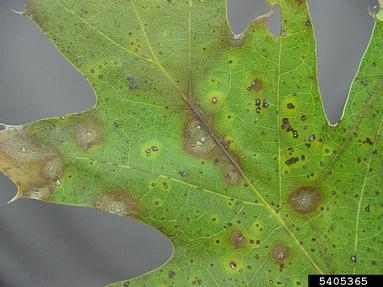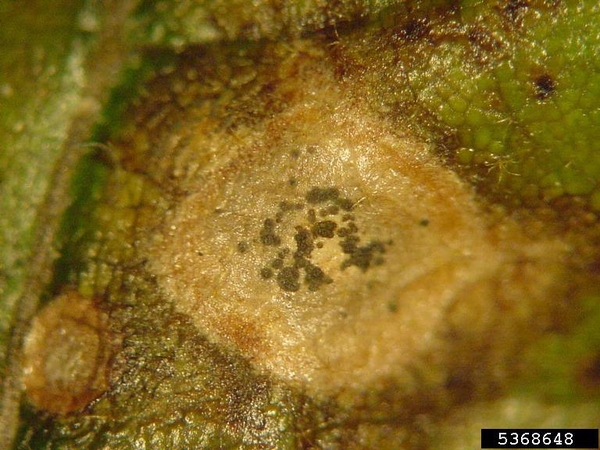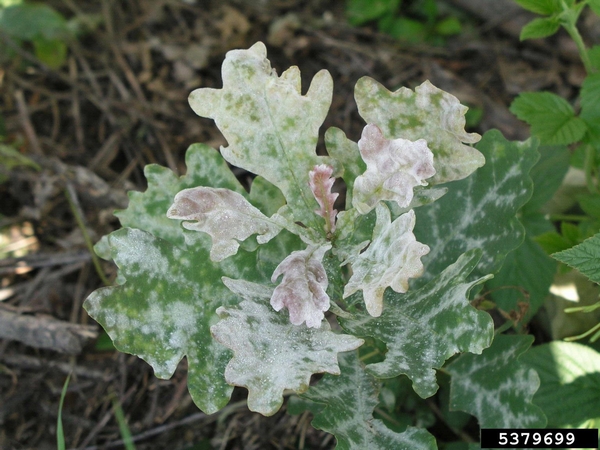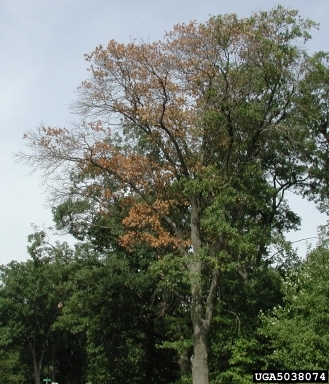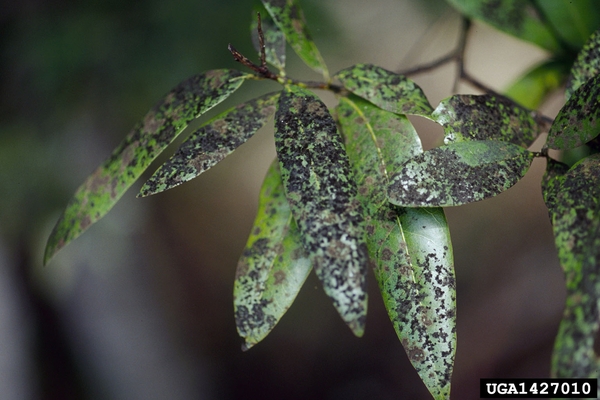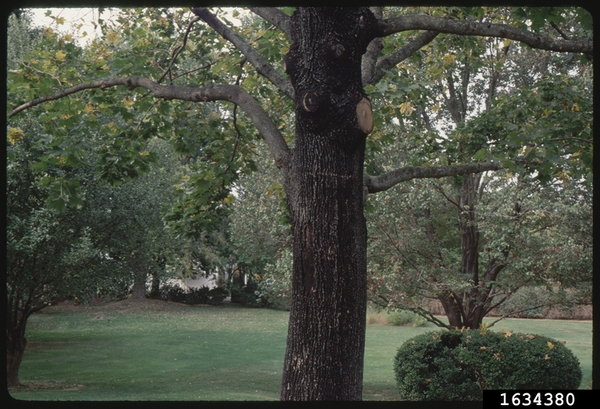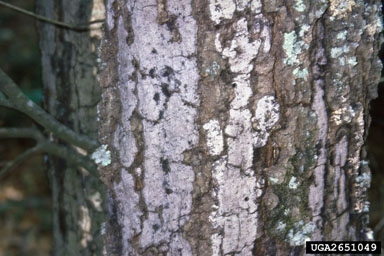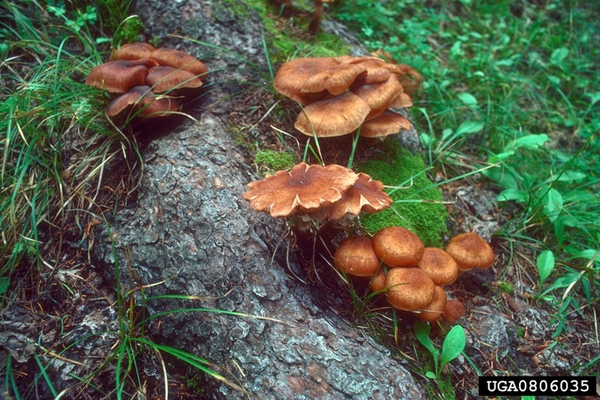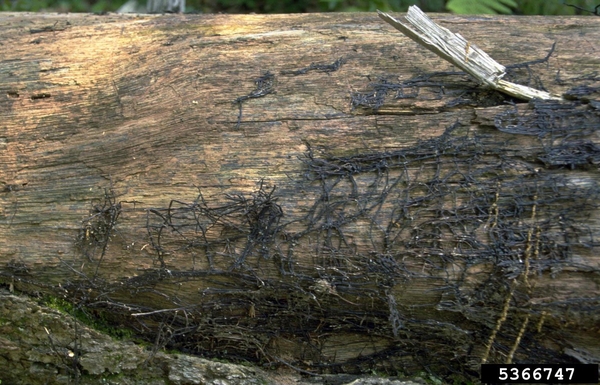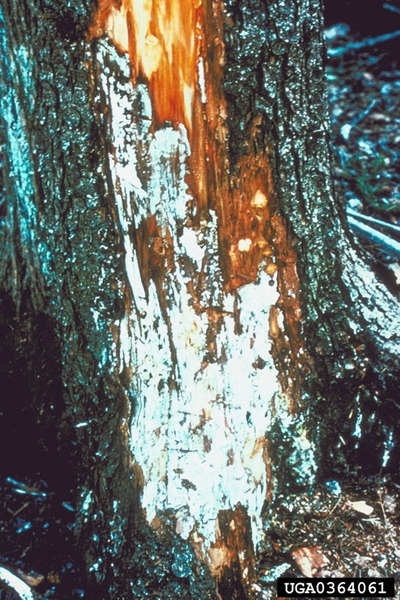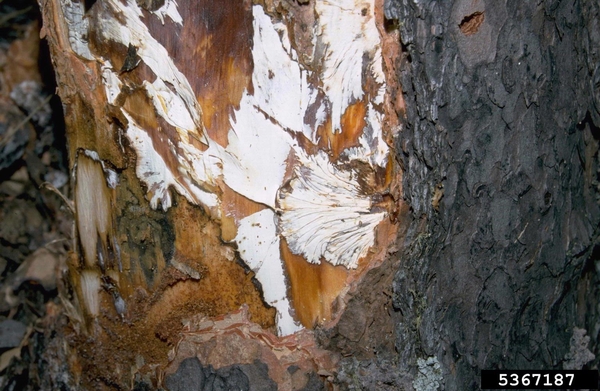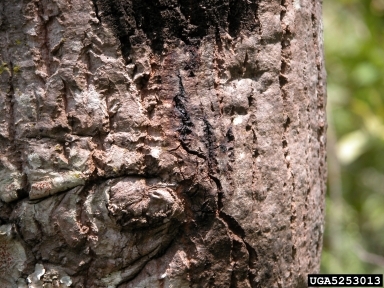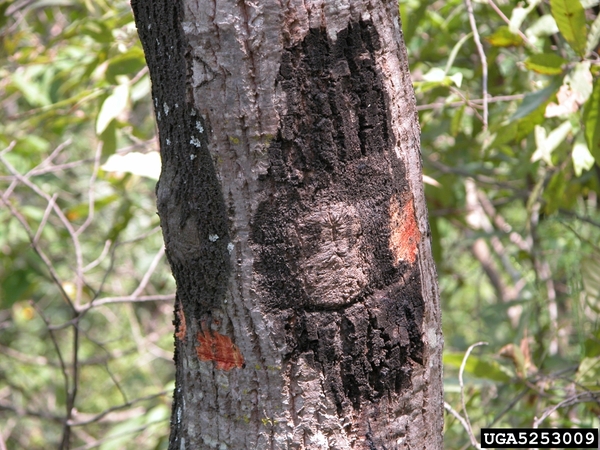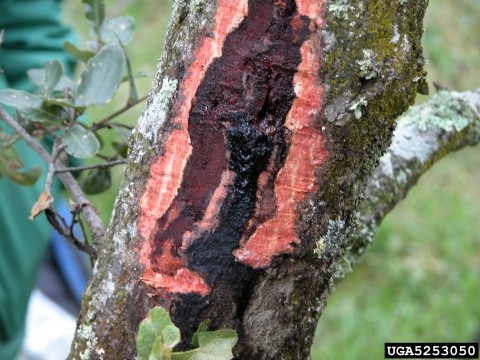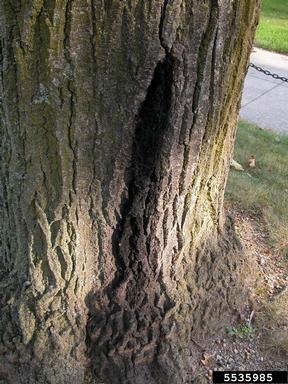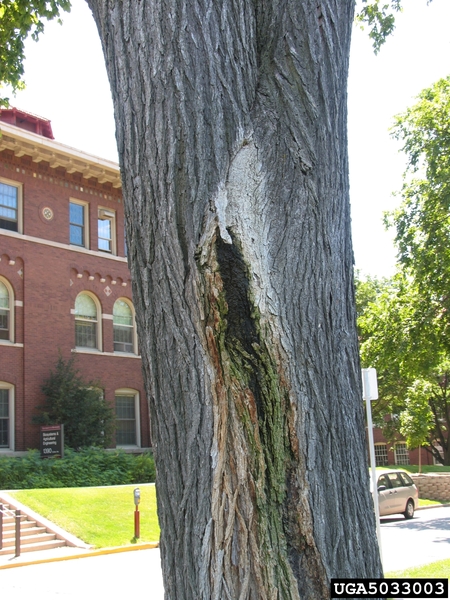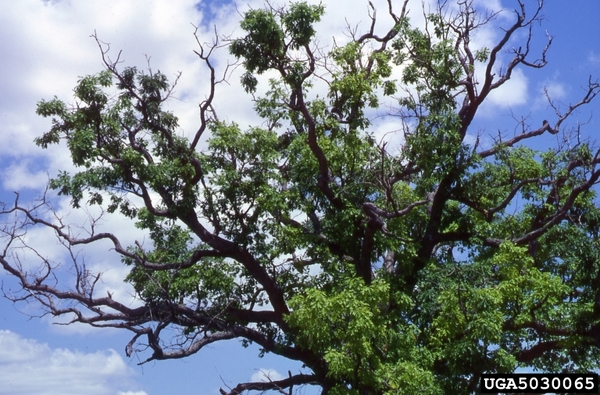Introduction
Many diseases can impact oak (Quercus spp.). Damage ranges from aesthetic damage to tree mortality. Symptoms vary greatly and can be include leaf deformation and necrosis, premature leaf drop, dieback, fungal growth of many forms, and more. This guide is intended to assist North Carolinians diagnose common disease issues of oaks utilizing images and short descriptions and includes links to more details synopses of the disease pest.
Oak Leaf Blister
Oak leaf blister (caused by Taphrina caerulescens) is a fungal disease that most commonly affects red oak species. The disease causes blister-like yellow (chlorotic) raised spots on leaves. As the blisters accumulate, the leaf will curl. In severe cases, leaves may drop prematurely. The pathogen spends the winter on leaf scales and buds, and spores infect the leaves in early spring. More information about oak leaf blister can be found from Penn State Extension.
Bacterial Leaf Scorch
Bacterial leaf scorch (caused by Xylella fastidiosa) is a serious disease which often results in tree feath over time. It most frequently affects red oak, white oak, pin oak, and shingle oak. The symptoms are often described as similar to drought stress, and include leaf burn (browning on leaf tips), leaf drop, and a discolored, yellow margin separating the dead tissue from living tissue, often occurring in mid to late summer. It is typically concentrated to one portion of the canopy rather than spread evenly through the crown. The disease progresses every year, causing more symptoms through time. Additionally, it can be spread by leafhoppers, including the grass sharpshooter and the redheaded sharpshooter (Draeculacephala minerva and Xyphon fulgida, respectively). More information about scorch diseases can be found from NC State Extension.
Anthracnose
Anthracnose is a broad term for a group of diseases that cause lesions on multiple plant parts, most often and notably foliage. In oaks, anthracnose is caused by the fungus Apiognomonia quercinia. Symptoms begin in the spring; leaves develop brown lesions and may shrivel. These lareas of dead tissue often develop along leaf veins, as this is where water accumulates and lingers, an ideal condition for fungal growth. In most cases, damage is aesthetic in nature and does not cause lasting impacts to tree health. Disease occurrence can be reduced by thinning the canopy to increase air flow and raking leaves in the fall to reduce disease innoculum. More information about anthracnose can be found from the NC Forest Service.
Tubakia/Actinopelte Leaf Spot
Tubakia/Actinopelte leaf spot (caused by Tubakia dryina) favors trees in wet and humid conditions. Red oaks are generally more susceptible than white oaks. The main symptoms of this disease are circular, reddish-brown blotches (lesions) on the leaves which arise in late summer as scattered leaf spots with a yellow 'halo' around them. The lesions contain visible shield-shaped fruiting bodies and may coalesce, causing large areas of dead leaf tissue and contributing to premature leaf drop. Tubakia/Actinopelte leaf spot is primarily an aesthetic disese and can be reduced through removal of fallen, infected leaves. More information about leaf spot diseases can be found from NC State Extension.
Powdery Mildew
Powdery mildew (caused by Erysiphe spp. and other genera) affects many species of oak during the spring and early summer, when the days are warm and nights are cool. Symptoms consist of whitish or gray spots on the upper leaf. The disease survives the winter on various plant tissues. Overall, the damage is superficial, but can be of large concern to ornamental growers and gardeners. More information about powdery mildew can be found from NC State Extension.
Oak Wilt
Oak wilt (caused by Bretziella fagacearum) is an exotic disease that is most damaging to the red oak group. It is a lethal disease found in several counties in Western NC. Common symptoms of oak wilt include leaf loss within the crown and widespread wilting. Dead trees may exhibit spore mats that rupture the bark adn smell sweet, attracting sap-feeding beetles. These beetles can then move spores to uninfected trees, facilitating the spread of the disease. The disease can also spread to nearby trees vias root grafts. If properly identified, oak wilt can be managed through severing root grafts, systemic fungicide treatments, and planting resistant trees. Pruning should be avoided in the spring in areas where oak wilt is present. More information about oak wilt can be found from the US Forest Service.
Sooty Mold
Sooty mold (various species) is associated with sucking insect pests, such as aphids, scale, and whiteflies. These insects produce honeydew, a sweet excrement that falls beneath them as they feed and facilitates the growth of sooty mold. Any foliage type and even non-living items can harbor this fungal growth. Sooty mold can persist long after the insects leave the plant, however it is not harmful to the plant. The tell-tale sign of sooty mold is black, rusty growth on the foliage and stems of the plant. When rubbing sooty mold with fingers, it will rub off, as it is not a true disease of foliage. Though infestations are usually not harmful, large amounts of sooty mold growth can cause photosynthesis inhibition and severely limit the aesthetic value of an ornamental plant. If sooty mold is observed on a plant, it is best to look above the growth for infestations of sucking insect pests. More information about sooty mold is available from NC State Extension.
Biscogniauxia (Hypoxylon) canker
Biscogniauxia (Hypoxylon) canker (caused by Biscogniauxia atropunctata var. atropunctata) most often affects post oak, water oak, blackjack oak, white oak, laurel oak and southern red oak. The disease is opportunistic, attacking trees already weakened or stressed by abiotic factors or other pests. Symptoms include yellowing/wilting of leaves and gray-tan fungal mats (also known as stroma) below the outer bark of trees. Bark may slough off, revealing these gray, smooth areas. Like many opportunisit disease agents, proper tree care is the key to preventing infection of this pathogen. More information about Biscogniauxia canker can be found from Texas A&M Extension.
Armillaria Root Rot
Armillaria root rot (caused by Armillaria mellea) typically becomes a problem in older or stressed trees and can be aggressive in some cases. Symptoms include leaf drop, dieback, growth reduction, and bark that is spongy or wet. There are three main diagnostic signs of this disease: white fungal mycelial (root-like) fans under the bark, rhizomorphs (look like black strings) under the bark or around the base of the tree, and yellow-orange mushrooms growing near the tree in clusters. This disease is incredibly difficult to treat, as the fungus lingers in old wood and the soil following tree death or removal. More information about Armillaria root rot can be found from NC State Extension.
Phytophthora Root Rot
Phytophthora root rot (caused by Phytophthora spp.) is common among not only oaks, but across many different types of plants. Leaves brown and the tree may begin to experience general decline. The tree may undergo a slow decline or a rapid decline, depending on growing conditions and the season. A tell-tale sign of Phytophthora root rot is a reddish-brown discoloration of the inner bark and roots. One species of Phytophthora (P. ramorum) is responsible for sudden oak death, which has devastated oaks in California and Oregon. This pathogen is currently not known to occur in North Carolina forests, but the NC Forest Service monitors for this pathogen annually. More information about Phytophthora root rot is available from NC State Extension.
Bacterial Wetwood / Slime Flux
Bacterial wetwood is a condition of bacterial infection that causes internal gas production from sap fermentation. As gasses buildup, the pressure forces sap to ooze from wounds or bark cracks, causing vertical streaks of dark liquid weeping out of bark crevices; this if often called “slime flux". It can be caused by multiple bacteria species, including Clostridium spp., Bacillus spp., and Pseudomonas spp. Slime flux can have a foul odor and can be unsightly, and the odor can attract other insects, including butterflies and stinging insects. If the tree was highly stressed before the infection, the bacteria can move into the sapwood, causing wilting and dieback. General tree care can help keep trees in healthier condition and slime flux can be washed off of trees, as long as the pressure does not harm the bark. More information about bacterial wetwood is available from Penn State Extension.
Oak Decline
Oak decline is not caused by a specific pest or disease, but is a result of several interactions between pests, diseases, and the environment. In some cases, tree health suffers for years and in others, the tree's health declines to mortality. Generally, oak decline begins with poor environmental or cultural conditions, rendering them susceptible to secondary pests and diseases. Armillaria root rot and the two-lined chestnut borer are two biotic factors commonly associated with oak decline. In general, proper tree care such as watering during dry spells and mulching to prevent damage and retain soil moisture, can help oaks stay healthy. More information about oak decline can be found from the NC Forest Service.
Publication date: April 5, 2022
N.C. Cooperative Extension prohibits discrimination and harassment regardless of age, color, disability, family and marital status, gender identity, national origin, political beliefs, race, religion, sex (including pregnancy), sexual orientation and veteran status.



